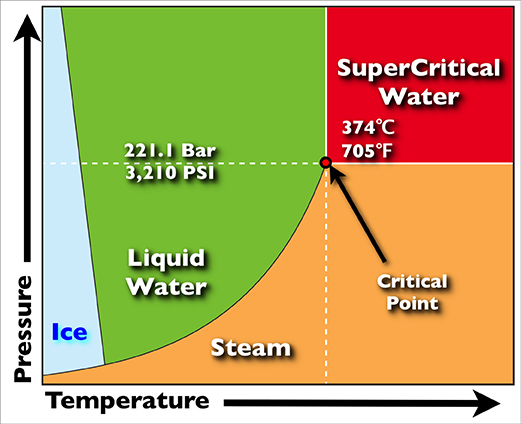|
Supercritical Steam Generator
A supercritical steam generator is a type of boiler that operates at supercritical pressure, frequently used in the production of electric power. In contrast to a subcritical boiler in which bubbles can form, a supercritical steam generator operates at pressures above the critical pressure. Therefore, liquid water immediately becomes indistinguishable from steam. Water passes below the critical point as it does work in a high pressure turbine and enters the generator's condenser, resulting in slightly less fuel use. The efficiency of power plants with supercritical steam generators is higher than with subcritical steam. Only with high pressure can higher temperature steam be converted more efficiently to mechanical energy in the turbine (as given by Carnot's theorem). Technically, the term "boiler" should not be used for a supercritical pressure steam generator as no "boiling" actually occurs in the device. History of supercritical steam generation Contemporary supercritica ... [...More Info...] [...Related Items...] OR: [Wikipedia] [Google] [Baidu] |
Supercritical H2Olr
Supercritical may refer to: Physics and technology Condensed matter physics * Critical temperature, TC, a temperature above which distinct liquid and gas phases do not exist for a given material ** Supercritical drying, a process used to remove liquid in a precisely controlled way, similar to freeze drying ** Supercritical fluid, a substance at a temperature and pressure above its thermodynamic critical point: *** Supercritical carbon dioxide: **** Supercritical fluid chromatography, a form of liquid chromatography using supercritical carbon dioxide as the mobile phase ***Supercritical water: **** Supercritical steam generator, a steam generator operating above the critical point of water, hence having no water–steam separation **** Supercritical water oxidation or SCWO, a process that occurs in water at temperatures and pressures above a mixture's thermodynamic critical point **** Supercritical water reactor (SCWR), a Generation IV nuclear reactor concept that uses supercritical ... [...More Info...] [...Related Items...] OR: [Wikipedia] [Google] [Baidu] |
Arkansas
Arkansas ( ) is a landlocked state in the South Central United States. It is bordered by Missouri to the north, Tennessee and Mississippi to the east, Louisiana to the south, and Texas and Oklahoma to the west. Its name is from the Osage language, a Dhegiha Siouan language, and referred to their relatives, the Quapaw people. The state's diverse geography ranges from the mountainous regions of the Ozark and Ouachita Mountains, which make up the U.S. Interior Highlands, to the densely forested land in the south known as the Arkansas Timberlands, to the eastern lowlands along the Mississippi River and the Arkansas Delta. Arkansas is the 29th largest by area and the 34th most populous state, with a population of just over 3 million at the 2020 census. The capital and most populous city is Little Rock, in the central part of the state, a hub for transportation, business, culture, and government. The northwestern corner of the state, including the Fayetteville–Springdaleâ ... [...More Info...] [...Related Items...] OR: [Wikipedia] [Google] [Baidu] |
Boilers
A boiler is a closed vessel in which fluid (generally water) is heated. The fluid does not necessarily boil. The heated or vaporized fluid exits the boiler for use in various processes or heating applications, including water heating, central heating, boiler-based power generation, cooking, and sanitation. Heat sources In a fossil fuel power plant using a steam cycle for power generation, the primary heat source will be combustion of coal, oil, or natural gas. In some cases byproduct fuel such as the carbon monoxide rich offgasses of a coke battery can be burned to heat a boiler; biofuels such as bagasse, where economically available, can also be used. In a nuclear power plant, boilers called steam generators are heated by the heat produced by nuclear fission. Where a large volume of hot gas is available from some process, a heat recovery steam generator or recovery boiler can use the heat to produce steam, with little or no extra fuel consumed; such a configuration is common ... [...More Info...] [...Related Items...] OR: [Wikipedia] [Google] [Baidu] |
Boiler
A boiler is a closed vessel in which fluid (generally water) is heated. The fluid does not necessarily boil. The heated or vaporized fluid exits the boiler for use in various processes or heating applications, including water heating, central heating, boiler-based power generation, cooking, and sanitation. Heat sources In a fossil fuel power plant using a steam cycle for power generation, the primary heat source will be combustion of coal, oil, or natural gas. In some cases byproduct fuel such as the carbon monoxide rich offgasses of a coke battery can be burned to heat a boiler; biofuels such as bagasse, where economically available, can also be used. In a nuclear power plant, boilers called steam generators are heated by the heat produced by nuclear fission. Where a large volume of hot gas is available from some process, a heat recovery steam generator or recovery boiler can use the heat to produce steam, with little or no extra fuel consumed; such a configuration is common ... [...More Info...] [...Related Items...] OR: [Wikipedia] [Google] [Baidu] |
Supercritical Water Reactor
The supercritical water reactor (SCWR) is a concept Generation IV reactor, designed as a light water reactor (LWR) that operates at supercritical pressure (i.e. greater than 22.1 MPa). The term ''critical'' in this context refers to the critical point of water, and must not be confused with the concept of criticality of the nuclear reactor. The water heated in the reactor core becomes a supercritical fluid above the critical temperature of 374 °C, transitioning from a fluid more resembling liquid water to a fluid more resembling saturated steam (which can be used in a steam turbine), without going through the distinct phase transition of boiling. In contrast, the well-established pressurized water reactors (PWR) have a primary cooling loop of liquid water at a subcritical pressure, transporting heat from the reactor core to a secondary cooling loop, where the steam for driving the turbines is produced in a boiler (called the steam generator). Boiling water reactor ... [...More Info...] [...Related Items...] OR: [Wikipedia] [Google] [Baidu] |
Heat Of Combustion
The heating value (or energy value or calorific value) of a substance, usually a fuel or food (see food energy), is the amount of heat released during the combustion of a specified amount of it. The ''calorific value'' is the total energy released as heat when a substance undergoes complete combustion with oxygen under standard conditions. The chemical reaction is typically a hydrocarbon or other organic molecule reacting with oxygen to form carbon dioxide and water and release heat. It may be expressed with the quantities: * energy/mole of fuel * energy/mass of fuel * energy/volume of the fuel There are two kinds of enthalpy of combustion, called high(er) and low(er) heat(ing) value, depending on how much the products are allowed to cool and whether compounds like are allowed to condense. The high heat values are conventionally measured with a bomb calorimeter. Low heat values are calculated from high heat value test data. They may also be calculated as the difference betw ... [...More Info...] [...Related Items...] OR: [Wikipedia] [Google] [Baidu] |
United States Energy Association
The United States Energy Association (USEA) is an association of public and private energy-related organizations, corporations, nonprofits, educational institutions, think tanks and government agencies. USEA works with the U. S. Department of Energy, U.S. Department of State and the U.S. Agency for International Development (USAID) to make energy accessible throughout the world by focusing on the viability of electricity, coal, oil, gas, nuclear and renewables. The organization also serves as a resource for the domestic and global energy industry, hosting a variety of events year-round that inform on current energy policy, challenges and technologies. Through its member organizations, USEA shares energy best practices, executes projects, and coordinates research domestically and internationally. Leadership In August 2020, USEA Chairman Sheila Hollis was named the Acting Executive Director of the association. Sheila is also of-Counsel and chair of the D.C. office of the law firm ... [...More Info...] [...Related Items...] OR: [Wikipedia] [Google] [Baidu] |
International Energy Agency
The International Energy Agency (IEA) is a Paris-based autonomous intergovernmental organisation, established in 1974, that provides policy recommendations, analysis and data on the entire global energy sector, with a recent focus on curbing carbon emissions and reaching global climate targets, including the Paris Agreement. The 31 member countries and 11 association countries of the IEA represent 75% of global energy demand. The IEA was set up under the framework of the Organisation for Economic Co-operation and Development (OECD) in the aftermath of the 1973 oil crisis to respond to physical disruptions in global oil supplies, provide data and statistics about the global oil market and energy sector, promote energy savings and conservation, and establish international technical collaboration on innovation and research. Since its founding, the IEA has also coordinated use of the oil reserves that its members are required to hold. In subsequent decades, the IEA's role expanded t ... [...More Info...] [...Related Items...] OR: [Wikipedia] [Google] [Baidu] |
Critical Point (thermodynamics)
In thermodynamics, a critical point (or critical state) is the end point of a phase equilibrium curve. The most prominent example is the liquid–vapor critical point, the end point of the pressure–temperature curve that designates conditions under which a liquid and its vapor can coexist. At higher temperatures, the gas cannot be liquefied by pressure alone. At the critical point, defined by a ''critical temperature'' ''T''c and a ''critical pressure'' ''p''c, phase boundaries vanish. Other examples include the liquid–liquid critical points in mixtures, and the ferromagnet–paramagnet transition (Curie temperature) in the absence of an external magnetic field. Liquid–vapor critical point Overview For simplicity and clarity, the generic notion of ''critical point'' is best introduced by discussing a specific example, the vapor–liquid critical point. This was the first critical point to be discovered, and it is still the best known and most studied one. The figu ... [...More Info...] [...Related Items...] OR: [Wikipedia] [Google] [Baidu] |
Center For American Progress
The Center for American Progress (CAP) is a public policy research and advocacy organization which presents a liberal viewpoint on economic and social issues. It has its headquarters in Washington, D.C. The president and chief executive officer of CAP is Patrick Gaspard, a former diplomat and labor leader, who served most recently as the president of the Open Society Foundations. Gaspard succeeded Neera Tanden, who was appointed special advisor to President Joe Biden in May 2021. Tanden previously worked for the Obama and Clinton administrations and for Hillary Clinton's campaigns. The first president and CEO was John Podesta, who has served as White House Chief of Staff to U.S. President Bill Clinton and as the chairman of the 2016 presidential campaign of Hillary Clinton. Podesta remained with the organization as chairman of the board until he joined the Obama White House staff in December 2013. Tom Daschle is the current chairman. The Center for American Progress has a ... [...More Info...] [...Related Items...] OR: [Wikipedia] [Google] [Baidu] |
CSIRO
The Commonwealth Scientific and Industrial Research Organisation (CSIRO) is an Australian Government The Australian Government, also known as the Commonwealth Government, is the national government of Australia, a federal parliamentary constitutional monarchy. Like other Westminster-style systems of government, the Australian Government ... agency responsible for scientific research. CSIRO works with leading organisations around the world. From its headquarters in Canberra, CSIRO maintains more than 50 sites across Australia and in France, Chile and the United States, employing about 5,500 people. Federally funded scientific research began in Australia years ago. The Advisory Council of Science and Industry was established in 1916 but was hampered by insufficient available finance. In 1926 the research effort was reinvigorated by establishment of the Council for Scientific and Industrial Research (CSIR), which strengthened national science leadership and increased ... [...More Info...] [...Related Items...] OR: [Wikipedia] [Google] [Baidu] |







